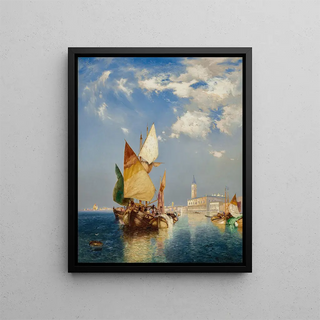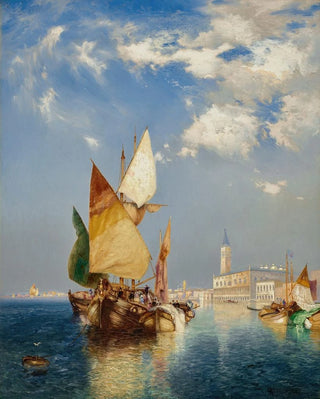Art print | The Grand Canal of Venice - Thomas Moran


View from behind

Frame (optional)
In the enchanting world of art, some artworks manage to capture the essence of a place so poignantly that they become timeless symbols. "The Grand Canal of Venice" by Thomas Moran is one of these creations that invite escapism. Gazing at this piece, the viewer is transported to the heart of the Serenissima, a city where time seems to stand still, and where every reflection on the water tells a story. Moran, master of landscape art, succeeds in evoking not only the physical beauty of Venice but also its romantic and melancholic atmosphere. The golden light caressing the facades of palaces and the movement of gondolas on the canal create a scene of rare poetry, inviting everyone to dream of a stroll along its banks.
Style and uniqueness of the work
Thomas Moran's technique is distinguished by his bold use of color and light. In "The Grand Canal of Venice," he skillfully plays with vibrant shades of blue and gold, creating a striking contrast that makes the canvas vibrate. The meticulous details of the buildings, reflections in the water, and fiery skies testify to his exceptional talent for rendering the ephemeral. Moran does not merely reproduce reality; he interprets, elevates, and transforms it into an almost dreamlike vision. Every brushstroke seems to be a declaration of love for the city, an ode to its fleeting beauty. It is this singularity that makes his work a masterpiece, capable of captivating the eye and evoking emotion.
The artist and his influence
Thomas Moran, an emblematic figure of the 19th-century American art movement, knew how to leave his mark on his era with his innovative approach to landscape art. Influenced by his travels in Europe, he incorporated elements of the Romantic tradition into his own style, while remaining faithful to his American roots. His passion for nature and his desire to depict it with emotional intensity made him a pioneer in landscape art. Moran also played a key role in the preservation of American landscapes, notably through his works that contributed to the creation of national parks. His influence endures

Matte finish

View from behind

Frame (optional)
In the enchanting world of art, some artworks manage to capture the essence of a place so poignantly that they become timeless symbols. "The Grand Canal of Venice" by Thomas Moran is one of these creations that invite escapism. Gazing at this piece, the viewer is transported to the heart of the Serenissima, a city where time seems to stand still, and where every reflection on the water tells a story. Moran, master of landscape art, succeeds in evoking not only the physical beauty of Venice but also its romantic and melancholic atmosphere. The golden light caressing the facades of palaces and the movement of gondolas on the canal create a scene of rare poetry, inviting everyone to dream of a stroll along its banks.
Style and uniqueness of the work
Thomas Moran's technique is distinguished by his bold use of color and light. In "The Grand Canal of Venice," he skillfully plays with vibrant shades of blue and gold, creating a striking contrast that makes the canvas vibrate. The meticulous details of the buildings, reflections in the water, and fiery skies testify to his exceptional talent for rendering the ephemeral. Moran does not merely reproduce reality; he interprets, elevates, and transforms it into an almost dreamlike vision. Every brushstroke seems to be a declaration of love for the city, an ode to its fleeting beauty. It is this singularity that makes his work a masterpiece, capable of captivating the eye and evoking emotion.
The artist and his influence
Thomas Moran, an emblematic figure of the 19th-century American art movement, knew how to leave his mark on his era with his innovative approach to landscape art. Influenced by his travels in Europe, he incorporated elements of the Romantic tradition into his own style, while remaining faithful to his American roots. His passion for nature and his desire to depict it with emotional intensity made him a pioneer in landscape art. Moran also played a key role in the preservation of American landscapes, notably through his works that contributed to the creation of national parks. His influence endures






